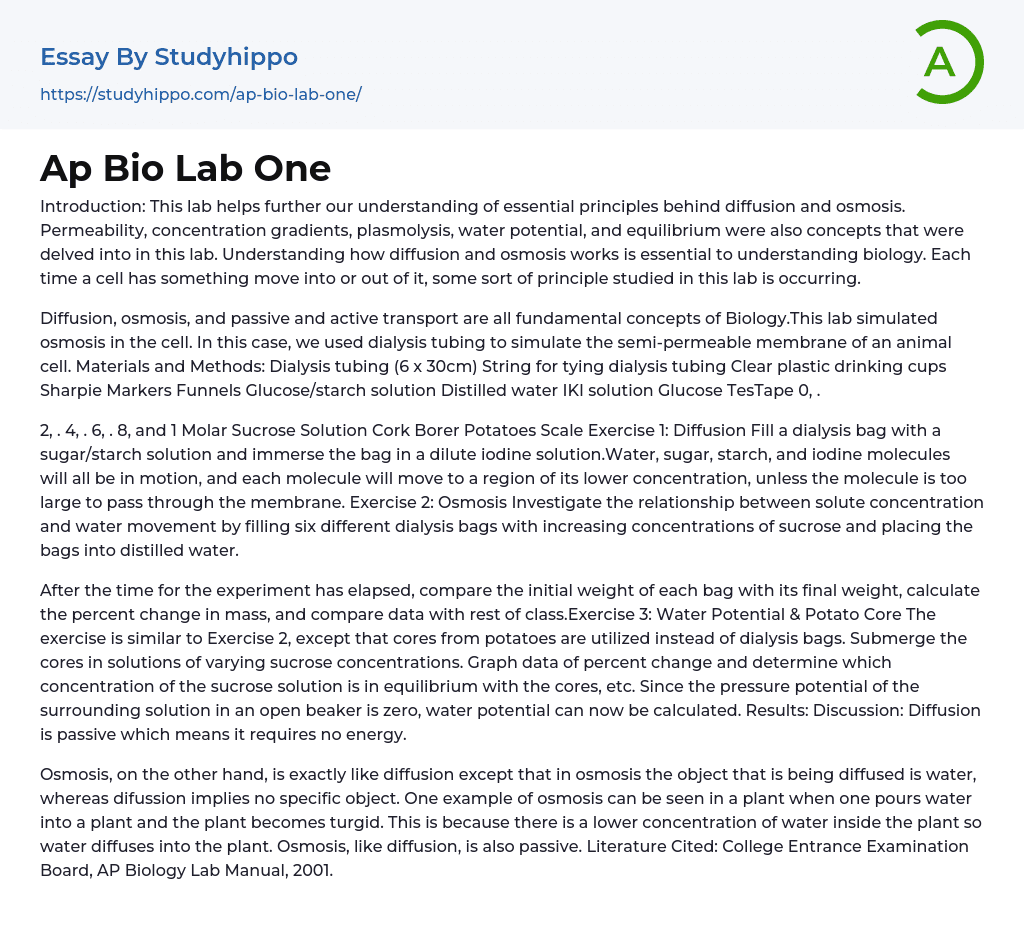Introduction: This lab helps further our understanding of essential principles behind diffusion and osmosis. Permeability, concentration gradients, plasmolysis, water potential, and equilibrium were also concepts that were delved into in this lab. Understanding how diffusion and osmosis works is essential to understanding biology. Each time a cell has something move into or out of it, some sort of principle studied in this lab is occurring.
Diffusion, osmosis, and passive and active transport are all fundamental concepts of Biology.This lab simulated osmosis in the cell. In this case, we used dialysis tubing to simulate the semi-permeable membrane of an animal cell. Materials and Methods: Dialysis tubing (6 x 30cm) String for tying dialysis tubing Clear plastic drinking cups Sharpie Markers Funnels Glucose/starch solution Distilled water IKI solution Glucose TesTape 0, .<
.../p>
2, . 4, . 6, . 8, and 1 Molar Sucrose Solution Cork Borer Potatoes Scale Exercise 1: Diffusion Fill a dialysis bag with a sugar/starch solution and immerse the bag in a dilute iodine solution.Water, sugar, starch, and iodine molecules will all be in motion, and each molecule will move to a region of its lower concentration, unless the molecule is too large to pass through the membrane. Exercise 2: Osmosis Investigate the relationship between solute concentration and water movement by filling six different dialysis bags with increasing concentrations of sucrose and placing the bags into distilled water.
After the time for the experiment has elapsed, compare the initial weight of each bag with its final weight, calculate the percent change in mass, and compare data with rest of class.Exercise 3: Water Potential & Potato Core The exercise is similar to Exercise 2, except
that cores from potatoes are utilized instead of dialysis bags. Submerge the cores in solutions of varying sucrose concentrations. Graph data of percent change and determine which concentration of the sucrose solution is in equilibrium with the cores, etc. Since the pressure potential of the surrounding solution in an open beaker is zero, water potential can now be calculated. Results: Discussion: Diffusion is passive which means it requires no energy.
Osmosis, on the other hand, is exactly like diffusion except that in osmosis the object that is being diffused is water, whereas difussion implies no specific object. One example of osmosis can be seen in a plant when one pours water into a plant and the plant becomes turgid. This is because there is a lower concentration of water inside the plant so water diffuses into the plant. Osmosis, like diffusion, is also passive. Literature Cited: College Entrance Examination Board, AP Biology Lab Manual, 2001.
- Microbiology essays
- Bacteria essays
- Cell essays
- Enzyme essays
- Photosynthesis essays
- Plant essays
- Natural Selection essays
- Protein essays
- Viruses essays
- Cell Membrane essays
- Human essays
- Stem Cell essays
- Breeding essays
- Biotechnology essays
- Cystic Fibrosis essays
- Tree essays
- Seed essays
- Coronavirus essays
- Zika Virus essays
- Melting essays
- Bottled Water essays
- Agriculture essays
- Albert einstein essays
- Animals essays
- Archaeology essays
- Bear essays
- Biology essays
- Birds essays
- Butterfly essays
- Cat essays
- Charles Darwin essays
- Chemistry essays
- Dinosaur essays
- Discovery essays
- Dolphin essays
- Elephant essays
- Eli Whitney essays
- Environmental Science essays
- Evolution essays
- Fish essays
- Genetics essays
- Horse essays
- Human Evolution essays
- Isaac Newton essays
- Journal essays
- Linguistics essays
- Lion essays
- Logic essays
- Mars essays
- Methodology essays




